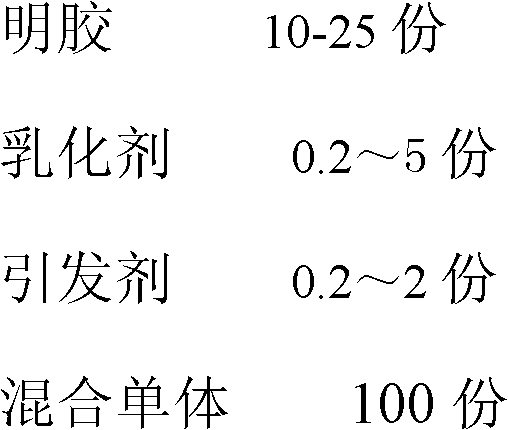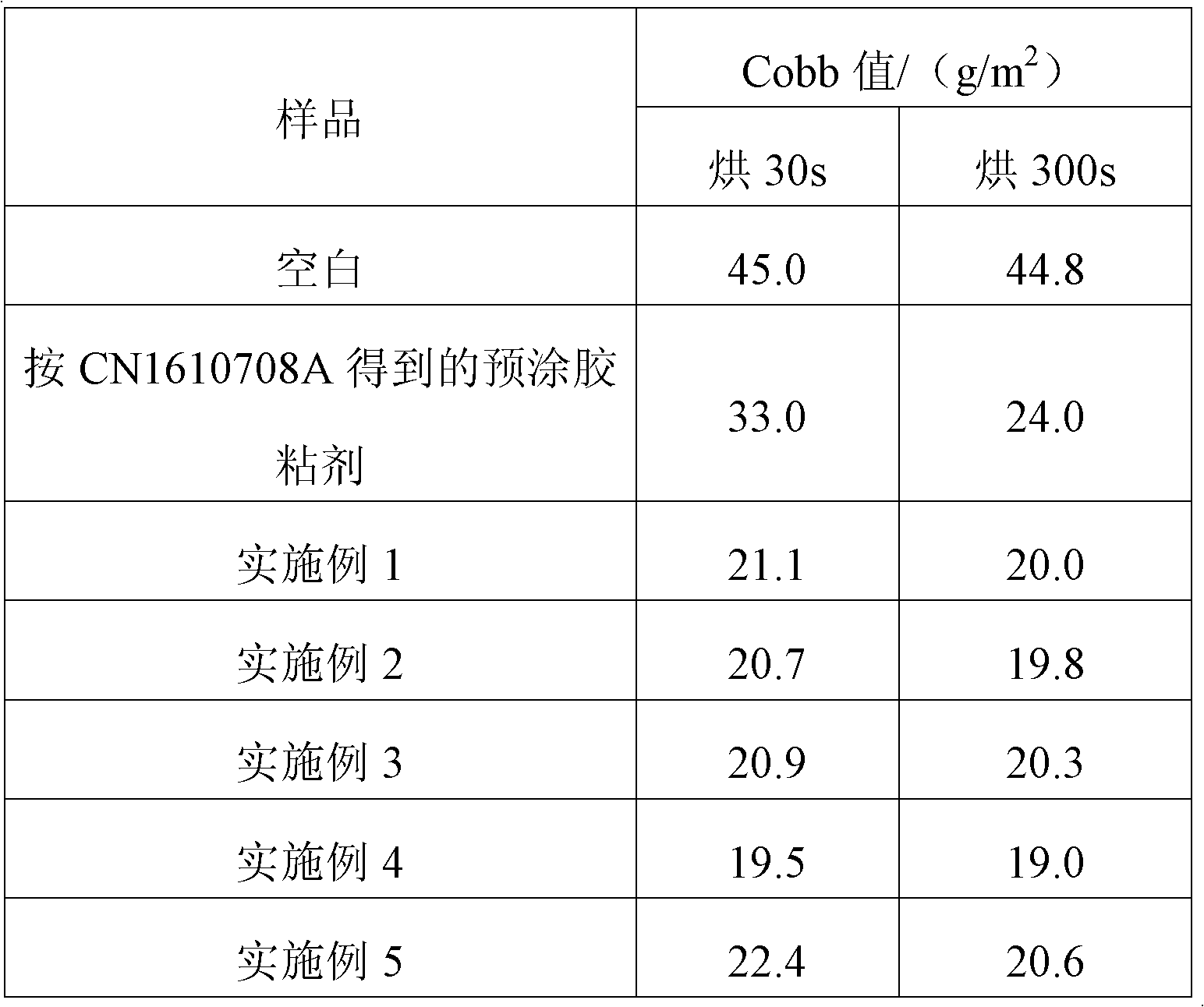Modified cationic latex and preparation method thereof
A cationic and latex technology, applied in the field of cationic latex, can solve the problems of high Cobb value, poor paper strength, slow curing speed, etc., and achieve the effect of reducing Cobb value, simplifying sizing process and rapid curing
- Summary
- Abstract
- Description
- Claims
- Application Information
AI Technical Summary
Problems solved by technology
Method used
Image
Examples
Embodiment 1
[0026] a) Mix 70 grams of n-butyl acrylate, 20 grams of styrene and 10 grams of dimethylaminoethyl methacrylate monochloromethane quaternary ammonium to prepare a mixed monomer for subsequent use.
[0027] b) Mix 0.2 g of octadecyl polyoxyethylene (5) trimethylammonium chloride with 10 g of deionized water, dissolve completely, and set aside.
[0028] c) 0.2 g of 2,2'-azobis(amidinopropyl) dihydrochloride and 10 g of deionized water were mixed, completely dissolved, and set aside.
[0029] d) Mix 0.1 gram of borax with 10 grams of deionized water, dissolve completely, and set aside.
[0030] e) Mix 10 grams of gelatin with a molecular weight of 5000 g / mol and 135.75 grams of deionized water, and heat up to 85° C. to dissolve completely. Add the emulsifier aqueous solution in step b) and control it at 95°C, add the 2,2'-azobis(amidinopropyl) dihydrochloride aqueous solution in step c), and then add a dropwise at 95°C ) step to mix the monomers for 1 hour.
[0031] f) Incubat...
Embodiment 2
[0033] a) Mix 30 grams of isooctyl acrylate, 50 grams of methyl styrene and 20 grams of dimethylaminoethyl methacrylate benzyl quaternary ammonium chloride to prepare mixed monomers, and set aside.
[0034] b) Mix 5 grams of lauryl polyoxyethylene (20) trimethylammonium chloride and 10 grams of deionized water, dissolve completely, and set aside.
[0035] c) 2 g of 2,2'-azobis(amidinopropyl) dihydrochloride and 10 g of deionized water were mixed, completely dissolved, and set aside.
[0036] d) Mix 1 gram of borax with 10 grams of deionized water, dissolve completely, and set aside.
[0037] e) Mix 25 grams of gelatin with a molecular weight of 50,000 g / mol and 522 grams of deionized water, and heat up to 85° C. to dissolve completely. Add the emulsifier aqueous solution in step b) and control it at 60°C, add the 2,2'-azobis(amidinopropyl) dihydrochloride aqueous solution in step c), and then add a dropwise at 60°C ) step to mix the monomers for 3 hours.
[0038] f) Incubat...
Embodiment 3
[0040] a) Mix 30 grams of ethyl acrylate, 30 grams of methyl methacrylate, 35 grams of styrene and 5 grams of dimethylaminoethyl methacrylate monochloromethane quaternary ammonium to prepare mixed monomers, and set aside.
[0041] b) Mix 3 grams of cetyl polyoxyethylene (10) trimethylammonium chloride and 10 grams of deionized water, dissolve completely, and set aside.
[0042] c) 1 gram of 2,2'-azobis(amidinopropyl) dihydrochloride and 10 grams of deionized water were mixed, completely dissolved, and set aside.
[0043] d) Mix 0.5 g of borax with 10 g of deionized water, dissolve completely, and set aside.
[0044] e) Mix 18 grams of gelatin with a molecular weight of 20,000 g / mol and 274.5 grams of deionized water, and heat up to 85° C. to dissolve completely. Add the emulsifier aqueous solution in step b) and control it at 80°C, add the 2,2'-azobis(amidinopropyl)dihydrochloride aqueous solution in step c), and then add dropwise a at 80°C ) step to mix the monomers for 2 h...
PUM
| Property | Measurement | Unit |
|---|---|---|
| particle size | aaaaa | aaaaa |
| particle size | aaaaa | aaaaa |
| particle size | aaaaa | aaaaa |
Abstract
Description
Claims
Application Information
 Login to View More
Login to View More - R&D
- Intellectual Property
- Life Sciences
- Materials
- Tech Scout
- Unparalleled Data Quality
- Higher Quality Content
- 60% Fewer Hallucinations
Browse by: Latest US Patents, China's latest patents, Technical Efficacy Thesaurus, Application Domain, Technology Topic, Popular Technical Reports.
© 2025 PatSnap. All rights reserved.Legal|Privacy policy|Modern Slavery Act Transparency Statement|Sitemap|About US| Contact US: help@patsnap.com



